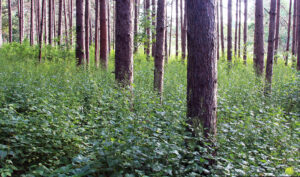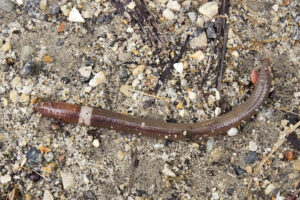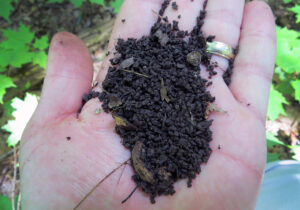
Avoid creating infestations of invasive plants — such as this huge patch of garlic mustard — on your wooded properties; don’t transport or plant aggressive spreaders as you head up north this summer. / Photo Credit: Steven Katovich, Bugwood.org
By Wisconsin Department of Natural Resources (DNR)
Hitchhiking invasive plants, insects and pathogens are worthy of concern.
As you dream of days spent at the cabin up north, planting your garden or wandering in the woods, here are a few reminders to help you avoid bringing hitchhiking invasives along as you enjoy your spring and summer activities.
- Know Your Plants
Many plants that we now recognize as invasive started as ornamental garden plants. Aggressive spreaders can easily escape cultivation and spread into nearby landscaping, natural areas or forested land. As you plan your plantings and start your seedlings, keep an eye out for prohibited and restricted invasive plants.
Wisconsin’s nurseries and garden centers are regulated by state agencies and must follow Invasive Species Rule NR40. However, your local plant swaps and garden club sales are not regulated in the same way, so invasive plants can be unwittingly swapped and spread around quickly.
Species may be unknown or have inaccurate descriptions. Since these types of meetups are not regulated, it can be difficult to guarantee exactly what you may be getting. Avoid any plants that are described as “quick spreading,” “aggressive” or “easy to grow” unless you can be certain about the species and its possible status as invasive. When possible, opt for native plants or non-native plants that are not aggressive or invasive.
Be aware of wildflower seed mixes, as they can contain the seeds of various invasive plant species. To avoid the risk of introducing a new infestation, be sure to read the label of seed mixtures before buying. If you aren’t sure whether a particular plant is invasive, try searching the plant name along with “invasive” and “Wisconsin” to verify.
- Leave Aggressive Species At Home
If you’ve stopped by a plant swap or sale and are trekking north to your cottage, permanent campsite or summer haunt, don’t bring any aggressive spreading plants with you. Some plants seem great for landscaping, like Bishop’s goutweed (often known as “Snow on the Mountain”), which can fill landscape gaps quickly. However, invasive plants like goutweed will continue spreading — even where you don’t want them — and can quickly crowd out native plants to create a monoculture, or inhibit tree regeneration.
More remote properties up north may border local natural areas, which can be vulnerable to invasion by harmful, non-native plants. The northern third of Wisconsin still has many natural areas that are not fully infested with invasive plants. Preserve the beauty of your favorite forests, trails and campgrounds by not transplanting your garden plants on your northern properties.
- Don’t “Soil” Your Property
Another reason not to transplant plants up north is the possibility of spreading hitchhikers. In addition to the plants you intend to move, many hitchhikers can come along and join in the planting, outcompeting the plants you desire and wreaking havoc on your landscaping or forested land.
Seeds from invasive plants such as garlic mustard are small and can easily be carried in the soil, causing new infestations of invasives when plants are replanted or transferred to a new location.
While you’re minding your soil, never dump yard waste into your wooded property, whether from your garden or from another location. While adding “green waste” to a pile or area of your property may seem harmless, invasive plant debris or seeds may be present in the pile and can quickly spread unwanted invasives to your woods.

Invasive jumping worms have a light-colored clitellum while most worm species have a raised, pink clitellum. / Photo Credit: Susan Day, UW-Madison Arboretum
4. Watch Out for Jumping Worms
Another nefarious hitchhiker to look out for is the invasive jumping worm. This non-native earthworm was found in Wisconsin in 2013 and can be easily spread when plants are swapped and planted in new locations.
Jumping worms (Amynthas spp.) earned their common name due to their lively behavior. They are very active, can move rapidly side-to-side and may resemble a writhing snake. They have a smooth, light-colored clitellum (the distinctive band near an earthworm’s head) while most worm species have a raised and pink clitellum. Jumping worms can also drop their tails if handled roughly.
One sign that an area may have jumping worms present is a distinctively grainy soil with the appearance of used coffee grounds. Invasive jumping worms grow rapidly and transform soil into loose castings (worm droppings). This is especially harmful in forests and poses a threat to plant establishment, tree root growth and nutrient uptake.

Soil that is infested with jumping worms has an appearance and texture similar to coffee grounds. / Photo Credit: Wisconsin DNR
To avoid bringing jumping worms home with you, examine any potted plants and gardening or landscaping materials carefully. If you do come across any writhing, snake-like earthworms on your property, report the sighting by emailing your location, photos and any other descriptive details to Invasive.Species@wisconsin.gov.
